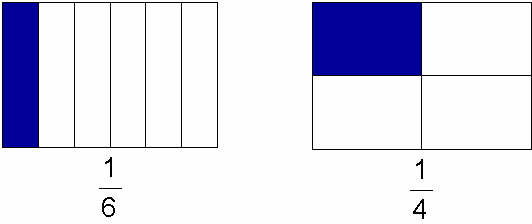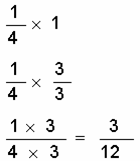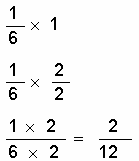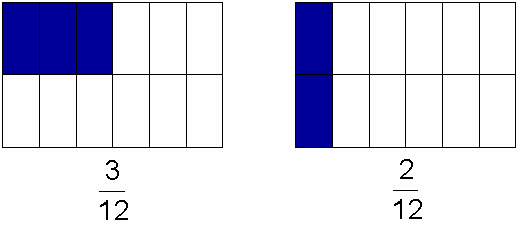Fractions
Add and Subtract Fractions with Different Denominators
Fractions with different denominators - or unlike fractions - must be changed to like fractions before we can add or subtract them. This is because with dissimilar denominators, two fractions represent parts of the whole which are of unequal size. This problem is illustrated in the figures below:

As you can see in the illustration, the two large squares are of equal size, but the parts expressed in the fractions are of different sizes. In order to put them together we need the shaded portions to be comparable. That is they must be divided into portions of equal size, or speaking mathematically, find a common denominator.
Step 1: Identify the lowest common denominator
To find the lowest common denominator (LCD) for two or more whole numbers, complete the following steps:
1. List the multiples for each number.Definition of a Multiple
When a number, N, is divisible by another number, x, we say N is a multiple of x.
Thus, 24 is a multiple of both 4 and 6 because the product of 4 and 6 is 24.Listing Multiples
To list the multiples of a number, start by multiplying the number by 1, then 2, then 3, and so on. For example, here are the first ten multiples of 4.
For 6, the first ten multiples are:
You could continue these lists indefinitely, but they are long enough to show that 4 and 6 possess many common multiples.
2.Identify the smallest multiple the denominators have in common.To find the lowest common multiple, list the multiples for each denominator in order with the smallest denominators list on top and the largest denominator’s list on the bottom.
Circle the first multiple that the denominators share. This is your lowest common denominator.
Step 2: Use equivalent fractions write fractions with the same denominator.
Writing Equations with the Lowest Common Denominator
Consider the previous example in which we have two rectangles of equal size, but divided terms of unequal fractions.
We use equivalent fractions to express these fractions in equivalent terms. We established the lowest common denominator of 4 and 6 is 12 in the previous section.
So, we want each fraction above to have 12 in the denominator. Multiplying each fraction by 1 will not change the fraction’s value, but will change the fraction’s form to an equivalent fraction with a denominator of 12.
In order to get 2 in the denominator, we multiply 4 by 3.
In order to get 12 in the denominator, we multiply 6 by 2.So we change “1” to a fraction with 3 in the denominator. So we change “1” to a fraction with 2 in the denominator. Now we multiply the numerators and denominators to get the equivalent fraction. Now we multiply the numerators and denominators to get the equivalent fraction. This changes the rectangles in the diagram example to the following:
Now we can add the two fractions because the fractional parts are in equivalent terms.
Practice:
Find the following sums and differences. Write your answer in lowest terms.





